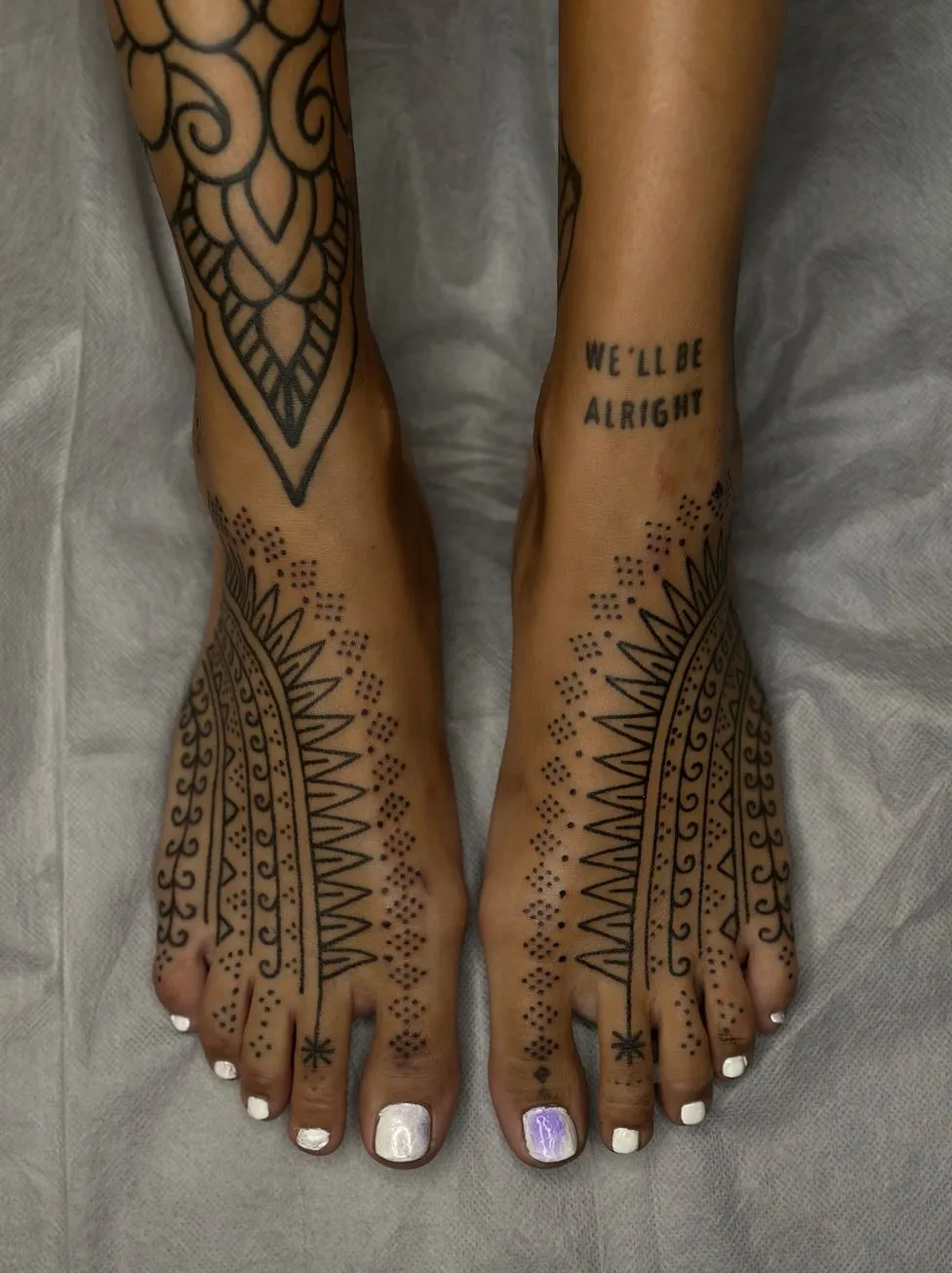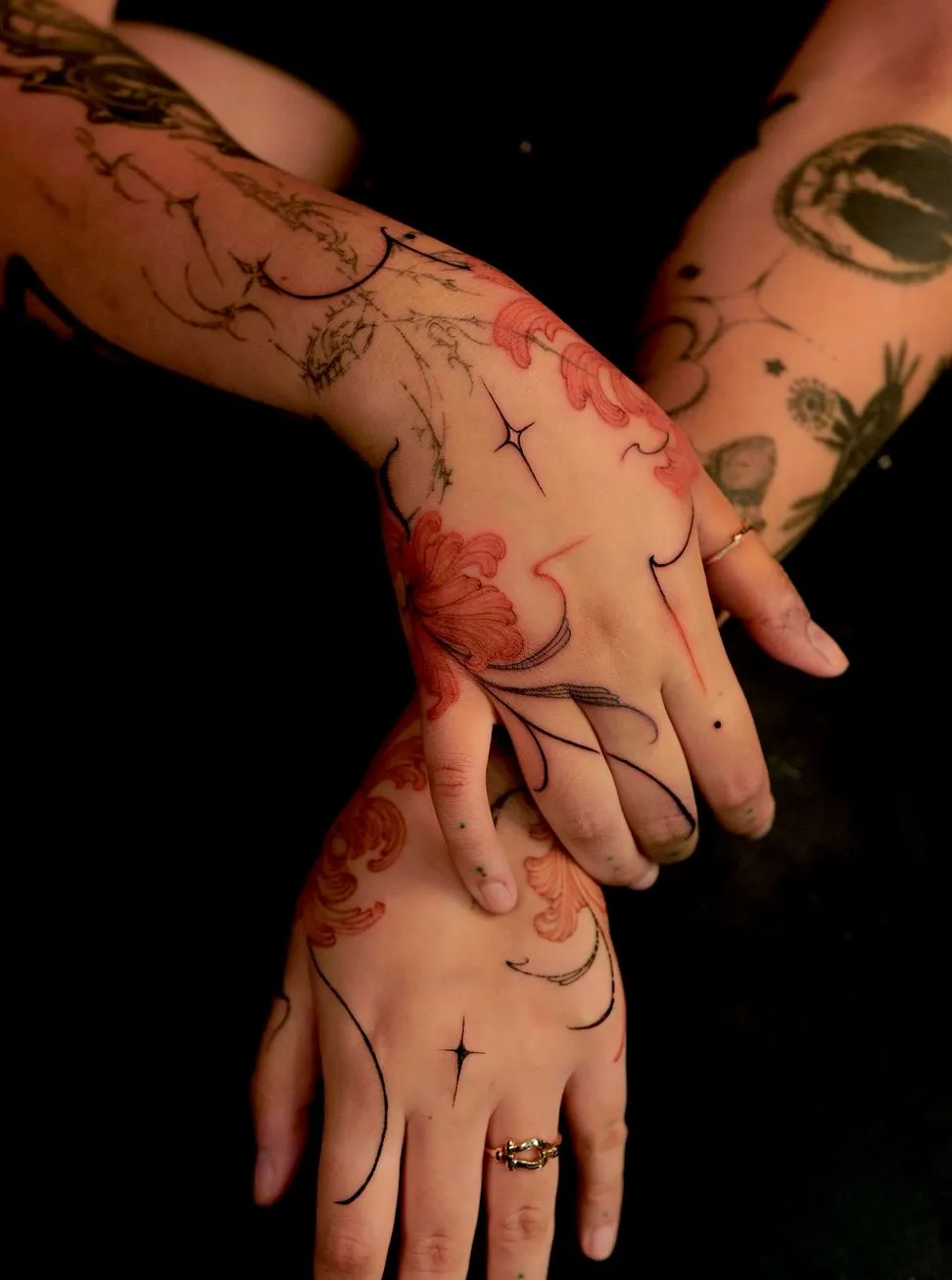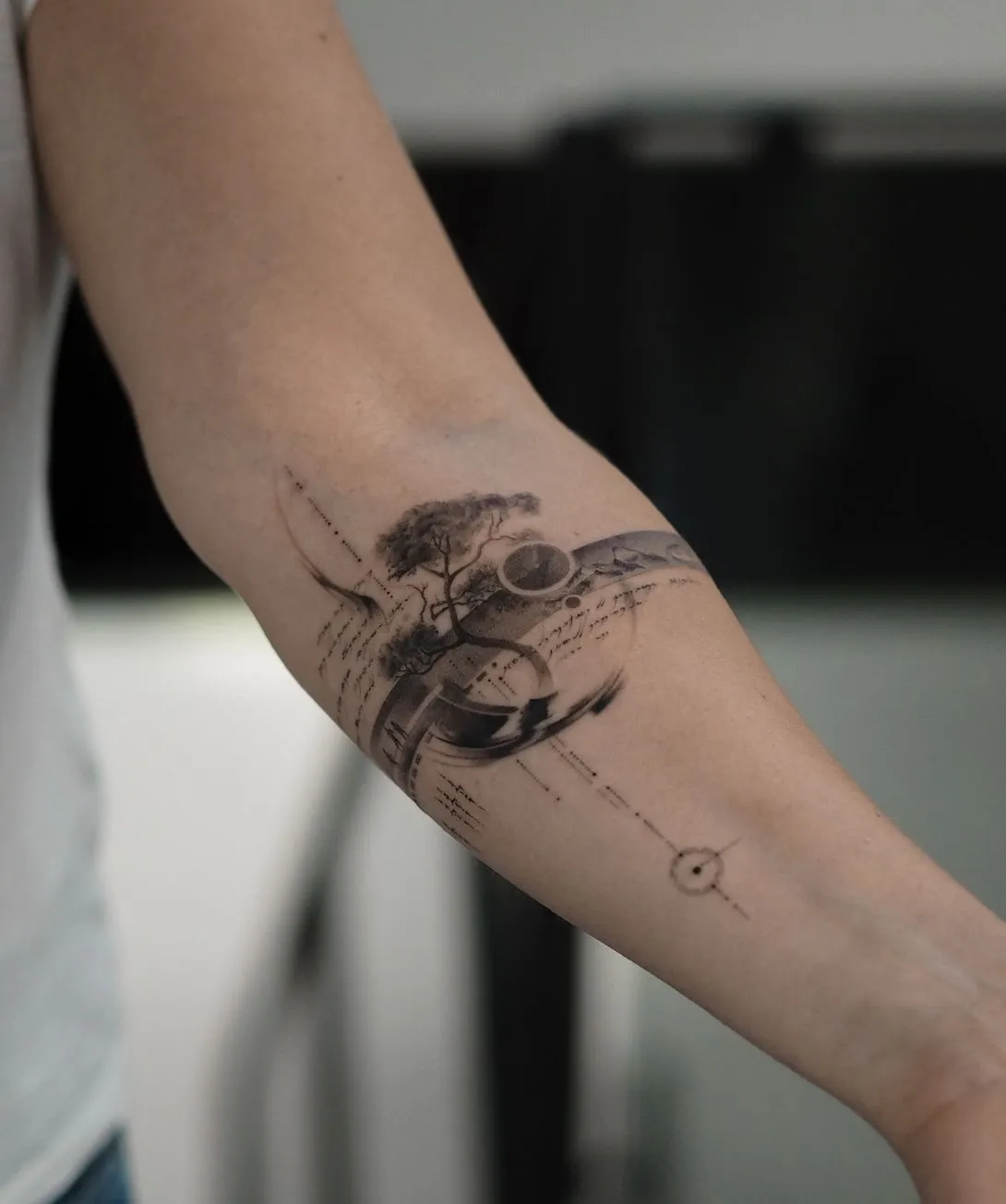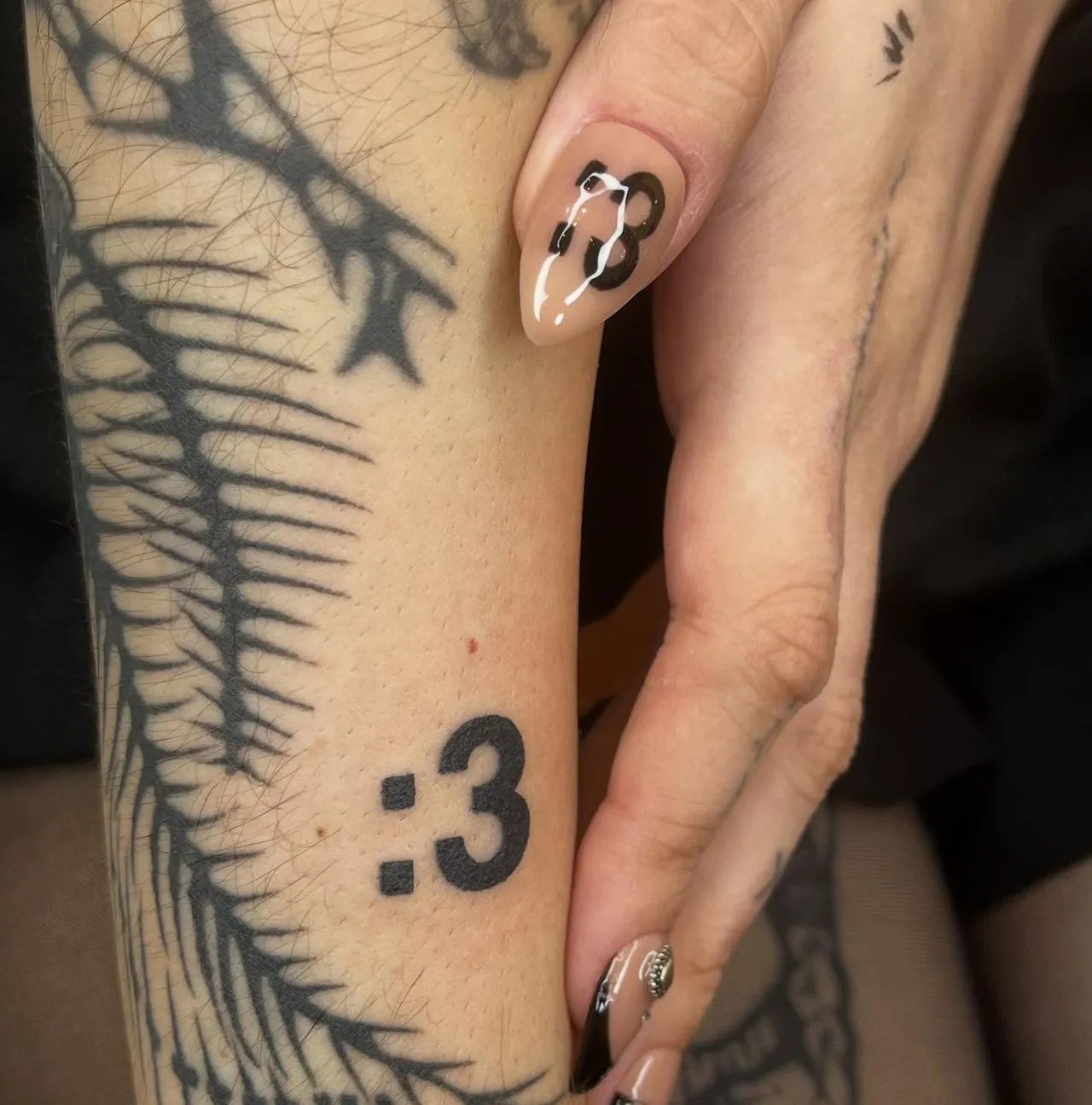What skin is prone to tattoo blowout? It’s one of the top questions we get asked by nervous clients before booking a tattoo session or cosmetic procedure. Whether you’re getting fine line work for your tattoo collection or subtle cosmetic enhancement like brows or lip blush, nobody wants blurry lines or a halo of tattoo ink spread beneath their skin.
We, Uliana Kasperska and Anastasia Petkov, are professional tattoo artists with over 15 years in the industry across Europe and Brisbane. We’ve corrected countless healed tattoos where ink had bled into the fat layer or subcutaneous tissue. Blowout isn’t always caused by inexperienced tattoo artists — sometimes it’s just about your skin type, density or healing process. In this article, we’ll break down what really causes blowouts, how to prevent them and what your options are if they happen.

Table of Contents
What Is A Tattoo Blowout?
Tattoo blowout is when tattoo ink travels further than intended beneath the skin. Instead of sitting neatly in the dermis, the ink pushes into the subcutaneous tissue — often called the fat layer. This creates a smudged or blurred appearance around the tattoo design, as though the lines have bled under tracing paper.
The tattooing process is meant to place pigment securely in the dermis, which is the middle layer of skin. If the needle penetrates too deeply, either from too much pressure, incorrect needle angle or poor control of the tattoo machine, ink can seep into the fat layer where it doesn’t stay contained. The result is tattoo ink bleeding out into neighbouring skin layers. The edges of a line tattoo can look fuzzy, while shading or fine line work may lose definition.
This doesn’t just happen with big body tattoos. Cosmetic tattooing — like brows, lips or eyeliner — is also prone to blowout, especially in high-impact areas with thinner skin layers. For example, lip blush tattoos can spread past the lip border if the tattooing process is too aggressive. Eyeliner tattoos on mature skin can sometimes migrate if the tissue is fragile. In every case, the issue is the same: ink is sitting in the wrong layer of skin.


The Role Of Skin Layers
To understand why some skin types are more prone to blowout, let’s look at the skin itself.
- Epidermis: This is the outermost layer. Ink placed here simply flakes off during the healing process, which is why tattoos that look overly dark in the first few days often lighten.
- Dermis: This is the “sweet spot” where healed tattoos are supposed to live. It has enough blood flow and collagen to lock in ink particles while still keeping them stable.
- Subcutaneous layer (fat layer): Go too deep, and this is where problems start. Ink in this layer spreads out instead of staying sharp, creating the blurry lines that clients dread.
A good tattoo artist will balance needle depth and angle for skin density. Unfortunately, inexperienced tattoo artists — especially those still in apprenticeship or rushing through a tattoo session — will push too hard or use the wrong needle penetration. That’s when tattoo ink gets into the fat layer and smudges long-term.
Skin Types That Can Impact Tattoo Line Clarity
Not all skin is created equal when it comes to tattooing. Some clients’ skin behaves beautifully, holds line work clean and crisp. Others, no matter how well the tattooing process is managed, will always present more risk.
Thin Or Fragile Skin
Thin or fragile skin is one of the biggest culprits. Think of areas like eyelids, wrists, ankles, and older clients with less collagen. In these cases, there’s very little dermis to work with. If the tattoo machine needle goes a fraction too deep, it hits the subcutaneous tissue straight away. That’s why fine line work on wrists or ankles often shows blurry halos over time.
In cosmetic tattooing, this is why mature brows can’t always take microblading. The hair strokes will blur quickly because thin skin doesn’t anchor pigment the way younger or denser skin does. Instead, techniques like powder brows or shading are safer.
Oily Skin
Oily skin seems unrelated to blowout, but it plays a big role during the healing process. Sebum secretion can push ink sideways, especially during the early healing stage when the skin is still sealing over. That’s why healed tattoos on oily skin often look softer with less crisp line work. For brows, this is why oily skin clients usually get better results from powder brows instead of microblading.
Highly Elastic Or Stretched Skin
Skin that stretches a lot — like lips, inner arms, stomachs or even parts of the ankle — has a tendency to let pigment migrate. Think of it this way: if your skin is moving constantly, ink particles don’t have time to settle evenly. That’s why blowouts are more common in tattoos placed on high-impact areas where the skin bends or folds often.
Mature Or Ageing Skin
Mature skin has multiple issues: it’s thinner, less elastic and doesn’t heal as fast. Collagen loss and fragile skin density make it easier for pigment to migrate into the surrounding tissue. We adjust our tattooing for older clients — lighter pressure, less pigment, smaller sections at a time. But mature skin is still more prone to blowout than younger skin.
Table: Skin Types Vs Risk Of Blowout
| Skin Type | Blowout Risk | Why It Happens | Safer Tattooing Practices |
| Thin / Fragile | High | The needle easily hits the fat layer | Light pressure, slower work, powder/shading |
| Oily | Moderate | Sebum disrupts healing and pushes pigment | Powder brows, careful aftercare, shading |
| Elastic / Stretched | High | Skin movement spreads ink in early healing | Smaller designs, a layered tattooing process |
| Mature / Ageing | High | Collagen loss + fragile density | Gentle passes, lighter pigment load |
| Normal / Balanced | Low | Stable density and healing process | Any professional tattoo techniques |

Other Factors Beyond Skin Type
Skin type is only part of the picture. Blowout risk also depends on:
- Tattooing practices: If the tattoo artist uses bad technique — wrong needle angle, too deep, or too many passes — the ink can spread.
- Skin trauma: Overworking an area during a tattoo session makes skin more prone to ink migration.
- Tattoo design: Fine line work looks cool, but shows blowout more than bold shading does.
- High-impact areas: Fingers, feet, lips, and eyelids are notorious for ink spread because the skin is thin and moving.
- Tattoo aftercare: Ignoring aftercare instructions is one of the biggest culprits. Sun exposure, sweating or scratching scabs during healing all increase the chance of blurry lines.
As we always tell our clients, your skin characteristics and your behaviour after the tattoo session both play equal roles in how sharp your healed tattoos look.
Prevention: How to Keep Tattoo Lines Sharp
Technique matters. A good tattoo artist knows how to control needle depth, angle and pressure. They also know how skin type and skin density affect the tattooing process. Don’t be afraid to ask about their apprenticeship, experience or if they’ve done the Artist Accelerator Program.
Match Design To Skin Characteristics
If you have thin or oily skin, fine line work may not heal as sharply. A good tattoo artist will suggest alternatives like shading or bolder tattoo designs. For cosmetic tattooing, oily brows often get better results from powder rather than microblading.
Follow Aftercare Instructions
Even the best tattooing techniques can’t protect against poor healing. Aftercare is half the result. Keep your tattoo safe from sun, trauma and unnecessary moisture during the healing process.
What to Do If Tattoo Ink Spreads
Not every blowout has to be a disaster. Mild ones will soften over time, and more noticeable ones can be fixed with cosmetic and medical solutions.
- Tattoo cover-up: A skilled tattoo artist can hide blurry lines with a new tattoo design.
- Laser tattoo removal: Q-switched lasers and the PicoWay system use energy beams to break down ink particles in the skin. Laser correction can sharpen up blurred edges so tattoos look sharp again.
- Saline removal: Common in cosmetic tattoo studios, this lifts pigment gently.
- Surgical tattoo removal (surgical excision): In severe cases where the ink has spread deep, surgical removal may be the last option. This is a cosmetic procedure and will leave a scar.

Real Client Story From Our Brisbane Studio
One client came in with a fine line wrist tattoo that had blurred into the surrounding tissue. The tattoo shop where she’d had it done used poor tattooing practices — too much needle penetration, too steep an angle and repeated passes over thin skin. The ink had travelled into the subcutaneous tissue, leaving a greyish haze around her original line work.
We started with three sessions of laser removal using a Q-switched: ND: YAG laser. The laser beams broke up the misplaced ink without damaging surrounding skin layers. Then we worked with her to plan a tattoo cover-up that blended in with her tattoo collection. Six months later, her wrist looked fresh and clean with no sign of the original blurry halos.
This shows blowout isn’t the end of the world — but prevention is always easier and cheaper than correction.
Final Thoughts
At Cosmetic Tattoo Studio Brisbane Face Figurati, we always remind our clients that tattooing isn’t just about the tattoo design. It’s about respecting the skin layers, understanding the subcutaneous tissue and working with safe professional tattooing practices. That’s how you get a tattoo collection you’ll love — crisp line work, healed tattoos that last and minimal risk of tattoo ink bleeding.

Using only natural and eco-friendly components for cosmetics
Special unique receipes are the secret of our spa procedures.
Experienced and skilled staff will make your perfect day
Most of our beauties come from the recommendation
FAQ
Can a blowout fix itself?
Does blowout mean my tattoo artist was unskilled?
Not always. Even experienced tattoo artists get blowouts on tricky skin types, but inexperienced tattoo artists increase the risk.
Can a laser fix a blowout?
Yes. Laser tattoo removal, especially with Q-switched lasers or PicoWay systems, can blur.
Can I prevent blowout with tattoo sunscreen?
Sunscreen doesn’t prevent blowout during the tattooing process, but it protects healed tattoos from fading and further pigment migration.
Is surgical tattoo removal safe?
Surgical excision or surgical removal is rare but sometimes necessary for severe trauma. It’s considered a cosmetic procedure with scarring risk.
